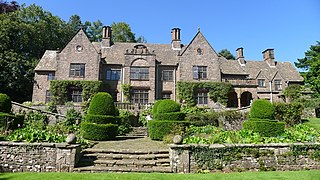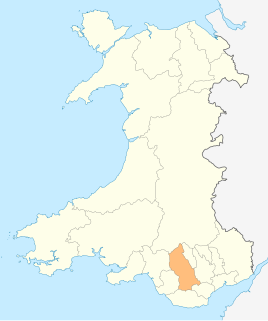
Ewenny Priory, in Ewenny in the Vale of Glamorgan, Wales, was a monastery of the Benedictine order, founded in the 12th century. The priory was unusual in having extensive military-style defences and in its state of preservation; the architectural historian John Newman described it as “the most complete and impressive Norman ecclesiastical building in Glamorgan”. Following the Dissolution of the Monasteries, parts of the priory were converted into a private house by Sir Edward Carne, a lawyer and diplomat. This Elizabethan house was demolished between 1803-1805 and replaced by a Georgian mansion, Ewenny Priory House. The house is still owned by the Turbervill family, descendants of Sir Edward. The priory is not open to the public apart from the Church of St Michael, the western part of the priory building, which continues to serve as the parish church for the village. The priory is in the care of Cadw and is a Grade I listed building.

Powis Castle is a British medieval castle, fortress and grand country house near Welshpool, in Powys. The seat of the Herbert family, Earls of Powis, the castle is known for its formal gardens and for its interiors, the former having been described as "the most important", and the latter "the most magnificent", in Wales. The castle and garden are under the care of the National Trust. Powis Castle is a Grade I listed building.

The River Taff is a river in Wales. It rises as two rivers in the Brecon Beacons; the Taf Fechan and the Taf Fawr before becoming one just north of Merthyr Tydfil. Its confluence with the River Severn estuary is in Cardiff.

John Batchelor was a prominent Welsh Victorian businessman and politician, who earned the epithet "Friend of Freedom".

Sir William Goscombe John was a prolific Welsh sculptor known for his many public memorials. As a sculptor, John developed a distinctive style of his own while respecting classical traditions and forms of sculpture. He gained national attention with statues of eminent Victorians in London and Cardiff and subsequently, after both the Second Boer War and World War I, created a large number of war memorials. These included the two large group works, The Response 1914 in Newcastle upon Tyne and the Port Sunlight War Memorial which are considered the finest sculptural ensembles on any British monument.

The Hayes is a commercial area in the southern city centre of the Welsh capital, Cardiff. Centred on the road of that name leading south towards the east end of the city centre, the area is mostly pedestrianised and is the location of the Hayes Island Snack Bar.

Cardiff Corporation Tramways was a company that operated an electric tramway service in Cardiff between 1902 and 1950.

Wyndcliffe Court, 0.5 miles (0.80 km) north of the village of St. Arvans, Monmouthshire, Wales, is a Grade II* listed country house and gardens in the Arts and Crafts style, completed in 1922. The client was Charles Leigh Clay and the architect Eric Francis with gardens designed by Henry Avray Tipping.

There are around 1,000 listed buildings in Cardiff, the capital city of Wales. A listed building is one considered to be of special architectural, historical or cultural significance, which is protected from being demolished, extended or altered, unless special permission is granted by the relevant planning authorities. The Welsh Government makes decisions on individual cases, taking advice from the heritage agency Cadw, the Royal Commission on the Ancient and Historical Monuments of Wales and local councils.

Monmouthshire is a county and principal area of Wales. It borders Torfaen and Newport to the west; Herefordshire and Gloucestershire to the east; and Powys to the north. The largest town is Abergavenny, with other large settlements being Chepstow, Monmouth, and Usk. The present county was formed under the Local Government (Wales) Act 1994, and comprises some sixty percent of the historic county. Between 1974 and 1996, the county was known by the ancient title of Gwent, recalling the medieval Welsh kingdom. The county is 850 km2 in extent, with a population of 95,200 as of 2020.

Merthyr Tydfil County Borough is located in the historic county of Glamorgan in Wales and takes its name from its largest town. The county borough covers an area of 111 km2 (43 sq mi) and had a population of approximately 60,400 in 2020. There are ten structures on the list of twelve Grade II* listed buildings in Merthyr Tydfil. Two viaducts constructed as part of the Brecon and Merthyr Railway both straddle the borders of neighbouring communities so have separate designations for each of these locations.

Monmouthshire is a county and principal area of Wales. It borders Torfaen and Newport to the west; Herefordshire and Gloucestershire to the east; and Powys to the north. The largest town is Abergavenny, with the other major towns being Chepstow, Monmouth, and Usk. The county is 850 km2 in extent, with a population of 95,200 as of 2020. The present county was formed under the Local Government (Wales) Act 1994, and comprises some sixty percent of the historic county. Between 1974 and 1996, the county was known by the ancient title of Gwent, recalling the medieval Welsh kingdom. In his essay on local government in the fifth and final volume of the Gwent County History, Robert McCloy suggests that the governance of "no county in the United Kingdom in the twentieth century was so transformed as that of Monmouthshire".

Rhondda Cynon Taf is a county borough in South Wales. It is located to the north-west of Cardiff and covers an area of 424 km2 (164 sq mi). In 2020 the population was approximately 241,900.

The Golden Cross is a Grade II listed public house at the junction of Customhouse Street and Hayes Bridge Road in the centre of Cardiff, Wales. The current building dates from 1903 and is noted for its distinctive ceramic tiling.

Llanerch Hall, Trefnant, Clwyd, Wales, is a country house with medieval origins. It was rebuilt twice at the beginning and at the end of the 17th century, was again rebuilt in the 19th century, and further modified in the 20th. The hall is now divided into flats, each with its own Grade II* listing. The parkland, now a golf course, conceals traces of a late 17th century Italianate terraced garden that rivalled those at Powis Castle. The gardens were entirely destroyed in the 19th century rebuilding. The house remains privately owned.

Craig-y-parc House is a country house in Pentyrch, Cardiff, Wales. Dating from 1914 to 1918, it was built for Thomas Evans, a colliery owner, by Charles Edward Mallows. The house reputedly cost £100,000. Craig-y-parc is a Grade II* listed building. The garden and park surrounding the house has its own Grade II* listing and is a designated conservation area. The house now operates as a residential school for children and young adults with disabilities.

The Treforest tinplate works in Treforest, Wales, operated between the late 18th century and 1939. The six remaining buildings on the site were constructed in the mid 19th century during which time the iron and tinplate industries were dominated by South Wales. These buildings form the best surviving group of tinplate manufacturing buildings in the region and are Grade II* listed.

















